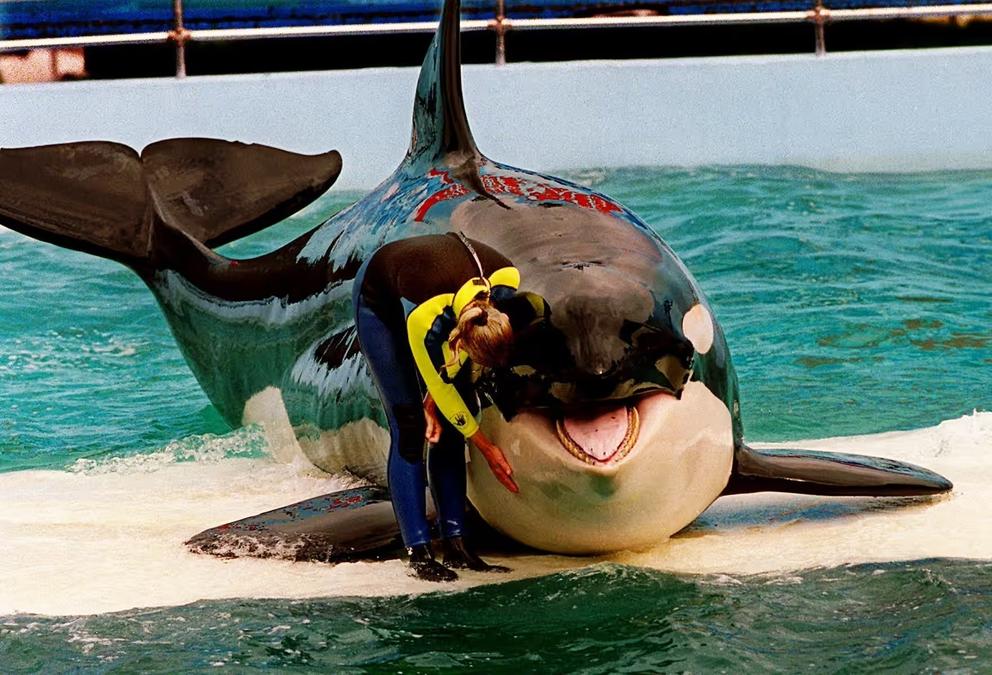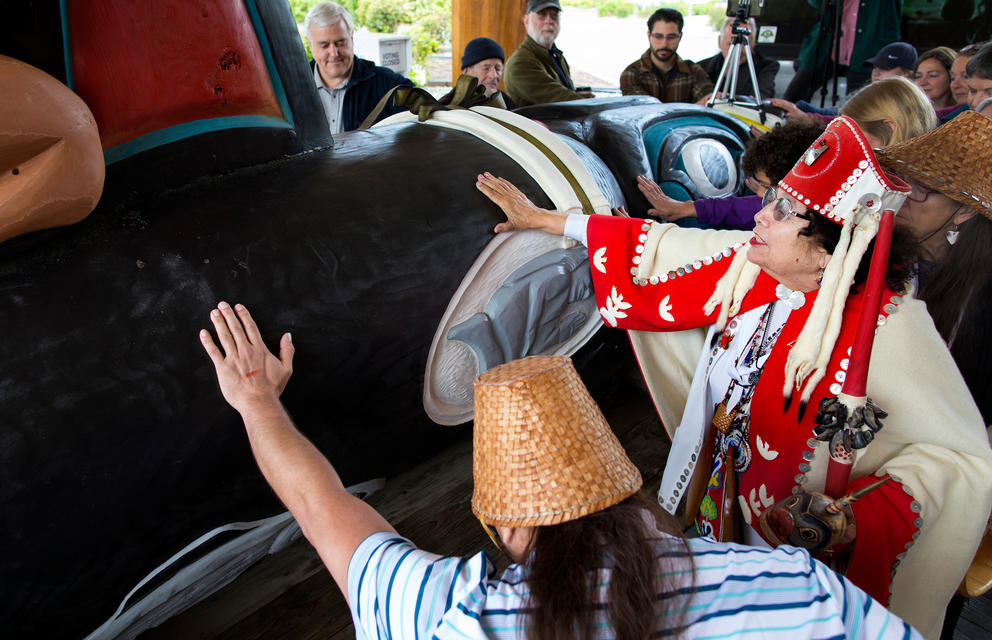The 7,000-pound orca died Friday, Aug. 18, at the Seaquarium of possible renal failure, Seaquarium officials announced that day. Television news cameras and amateur photographers filmed her body being loaded onto a semi-tractor trailer and the truck driving away.
The exact cause of death was to be determined by a necropsy, but the fate of her remains was not known. Raynell Morris, Lummi — a board member of two organizations that had campaigned for Tokitae’s return home — wrote on social media that she wants to bring Tokitae’s remains home so “we can give her the traditional and cultural funeral she deserves.”
The Lummi, or Lhaq’temish, people consider orcas to be their relatives and had long fought for Tokitae’s freedom. The Lhaq’temish word for orca is qwe 'lhol mechen, meaning “our relations below the waves.”
The Lummi Nation issued a statement about her passing.
“The Lummi Nation is saddened by the news that our beloved Orca relative has passed away at the estimated age of 57 years old,” according to the statement. “Our hearts are with all those impacted by the news; our hearts are with her family. We stand in solidarity with our Lummi members who poured their hearts and souls into bringing Sk’aliCh’elh-tenaut home.
“We will do all we can to start healing from this news and will begin talking about what needs to happen next.”
Stolen children
The orca’s first veterinarian at the Seaquarium named her Tokitae, a Coast Salish word meaning “nice day” or “pretty colors,” but a Lummi hereditary chief named her Sk’aliCh’elh-tenaut, which means member of Sk'aliCh'elh, a family of orcas who live primarily in the Salish Sea.
According to Sacred Sea, one of the nonprofit organizations of which Morris is a board member, Tokitae’s pattern of vocalizations matched those of other members of L pod, one of three pods of orcas that spend much of the year in the Salish Sea.
Tokitae’s life and death were opening and closing chapters of a long, painful story. She was one of six orcas captured on Aug. 8, 1970 in Whidbey Island’s Penn Cove, 57 miles north of Seattle, for sale to amusement parks.
In film footage of the capture, her pod can be heard making panicked sounds from outside the containment pen that held Tokitae and the other young orcas.
Until then, Tokitae had traveled with her pod in the open ocean from Alaska to Monterey Bay, California, following wild salmon runs that had sustained her family for millennia. She would spend the next 53 years of her life in a 35-by-80-foot tank 3,300 miles from home and family, performing under the name “Lolita.”
The memory of the 1970 capture haunted diver John Crowe for the rest of his life. Crowe, who died in 2015 at the age of 77, was part of the team that removed nine young orcas from their families; three of the orcas drowned in the process.
“All of the whales came over to the dock and stayed there and communicated back and forth [with their young],” he recalled. “It was just awful, the terror of ripping a baby animal away from its mother like that.”
He said in a 2013 documentary that the capture “is the worst thing that I've ever done.”
All told, 58 Southern Resident orcas — so designated because they spend much of the year in the Salish Sea — were captured in U.S. waters for amusement parks between 1966 and 1976. Orca captures were banned in the U.S. in 1972 with the passage of the Marine Mammal Protection Act, though some capture permits were issued to amusement parks that claimed economic hardship.
The captures reduced the Southern Resident population to 70, according to the Center for Whale Research, and the population has struggled to rebound since then. The population peaked at 97 in 1996, declined to 79 in 2001, and in July 2022 numbered 73. The orcas’ population recovery has been further challenged by reduced salmon runs, pollution and disturbance from vessels, according to the National Oceanic and Atmospheric Administration.
Tokitae was the last surviving Southern Resident orca in captivity. However, orcas from other populations remain in amusement parks. Among them is Corky, a member of the A pod of Northern Resident orcas, who was captured in Pender Harbour off the coast of British Columbia, Canada, in 1969. Corky has lived at SeaWorld in San Diego, California, since 1987.
Lummi Nation Chairman Anthony Hillaire told ICT on Saturday, Aug 19, that the feeling of kinship between the Lummi people and the orcas is deepened by shared experiences. Native children were removed from their families and sent to boarding schools, where they were often farmed out in the local community for cheap labor. Many children died from sickness and inadequate medical care. Orcas were removed from their families and sent to amusement parks where they were forced to perform for audiences. Only one captive orca — Keiko, born in Iceland — has returned home.
“There are some parallels to our story as Native people,” Hillaire said. “What kind of world do we live in where permits are issued for people to come in and kidnap a baby orca and take her from one coast to another coast so she can be put on stage to perform and make someone money and be held in a place that’s not natural to her, and to be held there for so long. For her to finally have a chance to come home and die before that happens, it’s pretty powerful. Unfortunately, that’s the world we live in. As Lummi people, we’ve experienced some of those traumas as well.”
But Hillaire said there’s another side to Tokitae/Sk’aliCh’elh-tenaut’s story.
“It’s not just the bad parts of the story and the bad policies, but our resilience — the good part about us as Lummi people,” Hillaire said. “Our elders and ancestors gave us what we needed to endure and to survive and to come out on the other side, never forgetting who we are and where we come from.”
Sacred Sea reported that in 2017 Tokitae was “singing the L-pod family song her mother taught her when she was a baby” – the same unique vocalizations that she was recorded making at the Seaquarium in the early 1990s.
“Although it’s very sad and tragic, we’re thankful for Sk’aliCh’elh-tenaut for bringing us all together,” Hillaire said. “What a great leader she was to bring the whole world together and give us this opportunity to look at ourselves — as individuals, as governments, as groups and agencies and policy makers: ‘What can we do better?’ ‘How can we be better?’ The main thing is we want to make sure this doesn’t happen again — for our whale relatives, for our children, for our loved ones and all of our family. We could not be at this place of change without her.”
In a May 2018 photo, Freddie Lane (left) from the Lummi tribe and Tlingit elder Anna Haala of Everett place their hands on a 16-foot totem pole at the Lummi Tribal Center in Bellingham. The pole was created to raise national awareness of the efforts to release the orca Tokitae from the Miami Seaquarium back to her home and family in the Salish Sea. (Karen Ducey for Crosscut)
An unexpected death
Irsay had funded improvements to Tokitae’s tank since her retirement from performing. Chlorine was replaced with an ozonator, the quality of her diet was improved, and she received regular health monitoring and care from a team of marine mammal veterinarians and marine biologists from Friends of Toki, a nonprofit that was working with the Lummi Nation to facilitate Tokitae’s return to the wild.
Drs. James McBain and Stephanie Norman reported July 31 that Tokitae had shown improvement from a bout of “abdominal/stomach discomfort” and was showing an increase in energy, appetite and engagement in daily activities.
“We continue to seek out the best quality fish for Toki, and are currently feeding the highest quality salmon, herring and capelin available on the market from 2023 catches,” they reported.
Tokitae’s death shocked all those who had worked for her return to the wild, and spurred calls for the release of other orcas held captive in amusement parks.
“Her miserable existence at the Miami Seaquarium — for interminable days, years, and decades — is finally over,” Jennifer O’Connor of PETA wrote on that organization’s website. “It’s too late for Lolita, but it’s not too late for other captive orcas, like those in SeaWorld’s tanks. Let’s all honor Lolita by refusing to buy a ticket to any marine theme park and to continue to call for the development of coastal sanctuaries” for the re-acclimation of freed marine mammals.
The Orca Conservancy, which was founded in 1996 as the Tokitae Foundation but later expanded its advocacy to include orcas in general, expressed deep sadness over Tokitae’s death and sent its “deepest condolences to our colleagues and the Lummi Tribe who worked so hard to advocate for her freedom.”
The Center for Whale Research, which maintains a southern resident population count for the National Oceanic and Atmospheric Administration, also issued a statement about her death.
“Heartbroken. A word that minimally describes the feelings we have,” the center stated. “She was captured and spent her life deprived of her family and a life of freedom. Thank you to all who dedicated their love and energy to try and change this. Toki will never be forgotten.”
Orca Network, an orca advocacy nonprofit that lobbied for Tokitae’s return home, planned a vigil in Tokitae’s memory Aug. 19 at the Langley Whale Center in the Whidbey Island town of Langley.
“One thing that brings us comfort is knowing that yesterday, as Toki began struggling and was on her journey home to the next world, her entire family was off the west side of San Juan Island in what these days is a rare gathering, with all three pods swimming up and down the island, socializing in a superpod,” Orca Network reported. “This is often a cultural/social ritual to mark a significant event in their community, and we believe they were welcoming her home.”
The organization added, “Toki is finally home, maybe not the way we wanted, but her family seems to know she is with them once again, in ways we may never comprehend.”
Sign up for ICT’s free newsletter.




